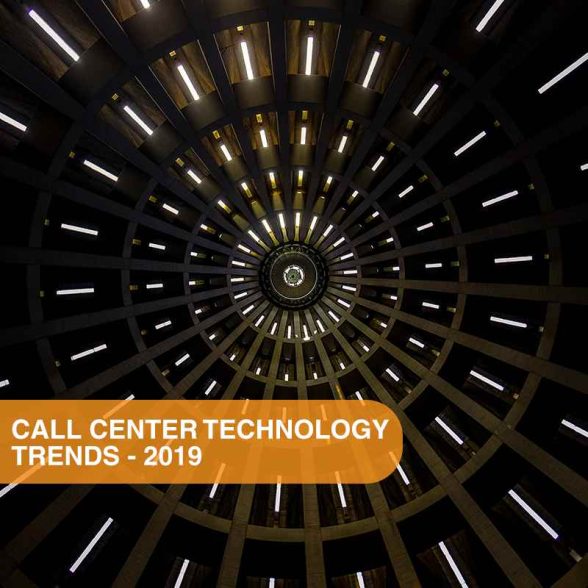- Resources
- Contact Center Trends 2019
Contact Center Trends 2019

In this article, we will explore:
How will technology impact and improve the contact center in 2019? 4 of our experts weigh in.
“The success of assistants like Google Home and Alexa has shown that voice is the most natural interface. In 2019, expect voice channels to pop up everywhere. Inside apps, on websites, in emails, in chats. Bots will become an integral part of business communication. Assistants will enter the contact center giving new tools to both agents and managers. AI will monitor every contact center interaction. CRM, Support Centers, Contact Centers, Sales…all these systems will continue to merge. Boundaries will blur as information flows more intelligently among (erstwhile) silos, uniting the customer journey” Chaitanya Chokkareddy, Principal Architect, Ozonetel Communications
Voice will dominate on brand new channels.
Voice is the most natural, easy medium for most people to communicate. Technology changes, this fact doesn’t. Voice lets people effortlessly exchange information while walking, driving, cooking or carrying out any regular activity. And remains unbeatably fast. (Voice conveys an average rate of 80-120 words per minute while people type at an average rate of 30-40 words per minute).
In 2019, you can expect new ways to enable to have these voice interactions with your customer. While the phone will continue to be a popular channel, here are 3 other options your inbound or outbound contact centers should look forward to:
Live chat windows will merge voice support.
Last year, we spoke about your customers’ need for switching between chat and voice on the same interaction. For example, chat windows may work for simple, quick interactions. But when people need to type in long explanations or get heated up about an issue —they’d really prefer to speak to and listen to a human voice. This year we expect KIA to enable more customers to do exactly that.
Voice bots will appear in calls, texts, and chats.
Wherever voice interactions can replace texting and keying in options, it will. Voice bots will make this scalable and easy. For example, expect voice bots to take over your IVR, chat windows and text messages. They can schedule appointments for your sales teams, qualify leads, ask your customers for feedback, give them reminders or help them to schedule, book or cancel their appointments, subscriptions, deliveries, and orders.
Digital Assistant will emerge as a new voice channel in the omnichannel journey.
Digital assistants like Alexa and Google Home continue to grow in popularity. Customers are already using “skills” to book their cab or place orders. We expect contact centers to take full advantage of this new channel, giving customers an easy means to reach them via their digital or even phone assistants.
“As with every year, in 2019, we can expect some things to change, and some things to remain the same. We can expect people’s preference for the voice channel to continue. And expect solutions to continue migrating to the cloud. But in 2019, Contact Centers will also start using their data more effectively thanks to AI and machine learning. Voice Bots will complete simple and repetitive tasks for inbound and outbound call centers. Live Call analysis will become a must-have for every contact center. And voice and text channels will merge and complement each other.” Sudhamay Maity, Project Manager, Ozonetel Communications.
Quality and Data will be managed better.
AI entered the contact center last year. In 2019, we will see more tools being adopted by more contact centers. The focus will be on improving both customer experience and the agent’s working environment. Expect predictive AI, Speech analytics and digital assistants to harness the data that enters the contact center. Here are 3 changes to expect:
Quality monitoring will dramatically improve.
CSAT is a critical metric to judge agent performance. But current methods of CSAT are not accurate, fair or customer friendly. For example, not all customers give feedback. Some customers also feel annoyed at being “pushed” into answering a feedback survey. This year you can expect AI to help. AI will analyze every conversation, and accurately judge sentiment at the beginning and end of the call. (Read more here) The real-time feedback will help agents tweak and improve their conversations as they take place. This will change how training can be done. Managers will get alerts if conversations are headed downhill, so they can prevent escalations in real time.
Digital Assistants will make it easy for agents to access data.
Integrations between systems will continue in 2019. With CRM, Social Media, and contact center information merging, it is already possible for agents to have customer information at their fingertips, during both inbound and outbound calls. (Screenpop integrations) Businesses who haven’t integrated yet will do so this year. Meanwhile, AI will make it even easier for your agents to access information. For example, let’s say your agent needs to access a “terms and conditions” document during a call. The digital assistant will listen to voice cues, pull out and display the document even while your agent continues conversing with the customer/prospect.
Data will be used more effectively
Contact Centres will use data to identify points of frustration and inefficiency. Managers will use predictive analytics to detect trends. Uses will vary from creating outbound call scheduling to planning agents for high incoming call volumes. Sentiment can be expected to become a part of the analytics framework.
“In 2019, expect smarter IVR systems for inbound calls and intelligent dialers for outbound calls. IVRs will perceive caller requirements based on caller history, purchase history, ticket information and other data linked with the incoming phone number and change the IVR flow accordingly. Dialers will improve answer rates by using the prospect’s answering history, to suggest the best times for scheduling calls. Expect gamification to improve agent engagement and motivation levels.” Gurumurthy Konduri, General Manager(Operations), Ozonetel Communications.
Smarter tools for inbound and outbound calls
AI and integrations will help build smarter tools across the board. Two important tools in the inbound and outbound that can be expected to become savvier are the IVR and the Dialer.
Smarter IVR
The IVR has been the focus of change for some time now. The time for long, clunky, boring IVR menus is over. Last year we unveiled many smart, modern IVR options designed for better customer experience. This year these changes will continue to mature. The focus will be on improving the experience by personalizing for each caller. IVR’s will use integrations, data and AI to tweak the IVR call flow/menu or routing based on a caller history. Improved Speech Recognition capabilities are likely to improve the experience further.
Smarter Dialers.
Answer rates are critical to the success of an outbound campaign whether the aim is to make a sale or to convey information. So far, dialers have been used to improve agent productivity by systematically dialing one number after the other. This year expect dialers to be smarter. They will also store or pull our information on a prospect or customer answer history and schedule calls for times the prospect is most likely to answer. This could greatly improve answer rates during outbound campaigns to known databases.
Gamification tools can improve the agent experience.
AI can also be used to make the workplace more fun. Gamification can help engage agents in what is otherwise often a boring, and thankless job. It could be as simple smiley at the end of good customer interactions. Or gameboard style scoreboards. There are many ways AI can automate rewards for high performers, and improve motivation levels.
“Contact Centers have moved from being cost centers to essential components of the customer journey, and vast sources of data. In 2019, Contact Centers will continue to value customer satisfaction above anything else. AI will complement rather than replace agents. All technology we implement will be customer-centric. Speed and easy access to a live agent will be important ingredients of every successful interaction.” CSN Murthy, Founder, CEO, Ozonetel Communications Customer.
Customer convenience will be paramount
At the end of the day, technologies are not applied for technology sake. Business objectives need to be met by providing value for the customer. And what do consumers want? “Ease of use” and speedy resolutions” are topmost on their wishlist. Enabling this customer convenience will be the focal point of all technology investments in the contact center.
Self-service will focus on increased CSAT
The focus of self-service will be to increase customer convenience. This year contact centers will identify tasks where customers prefer self-service. For example, last year Treebo used Self-service to provide faster cancellations. (Read our case study). This year, Voice Bots will improve the experience and possibilities that self-service can provide. This is expected to free up agents giving them the time and patience they need to ensure higher Csat on their interactions.
Easy access to live agents remains important.
A study published by MIT Sloan emphasized the need for providing human support when a new self-service technology is established. We’ve seen this play out with chatbots. For simple interactions, chatbots work fine, but if human support isn’t available fast during an escalation, it frustrated customers. Hardly surprising then, that CCW’s market study “The Future of Contact Center in 2019” showed that a whopping 64% organizations believe that easy access to a live agent is important. So while voice bots and self-service tools continue to mature, easy access to live agents anytime during the interaction will remain an important feature.
Omnichannel will mature
Omnichannel has been coming of age. Last year saw us integrating with Slack, Facebook, Whatsapp, Shopify, FreshDesk Mint along with all existing Zoho, Zendesk, Salesforce and other CRM integrations. Our open API’s ensure quick and easy integration with almost any and every other software platform, in the belief that integrations help provide a truly omnichannel experience. Along the customer journey, you can expect customers to browse, chat, message, email, text, and phone you. Integrations allow you to have a single, unified view of the customer and their journey.
Speed will remain important
Our Contact Center Performance Report 2018, showed a focus on speed with a 6 second Average Speed of Answer. Customers will continue to expect their problems to be solved fast (this year, and the next, and the next). So metrics like Average Speed of Answer. First Time Resolutions, Average Hold Time will continue to be important measures of how well your contact center is delivering this, no matter what the channel or technology.
Summary
Smart. Intelligent. Predictive. These sum up the 2019 technology trends within the call center space. New technological developments are likely to positively impact all aspects of contact center operations and communication. The emergence of voice, intelligent IVRs & dialers, the popularity of the cloud, AI & machine learning will be vital players. Agents and managers will be armed with nifty tools and data-driven intel to streamline operations, automate tasks, improve overall customer and employee satisfaction. With all these changes, the customer would continue to reign supreme. Technology would continue to serve, without replacing, but rather by partnering with agents.







